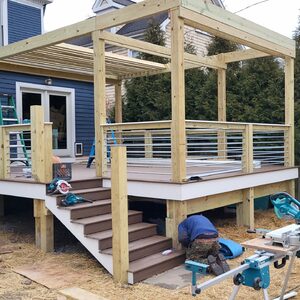how to protect an unheated basement floor in the winter?
I’m situated in Downeast Maine where frost usually shows up within a few weeks from now.
My father and I are building him a small retirement home but only plan to have the basement put in and then deck it over for the winter while we work on cabinets and other things, then resume in the early spring.
We are debating whether or not to pour the floor in the basement, which will be of a fiber concrete make-up, no rebar. Our concrete guy asked us if we were planning to heat the space and we said, we hadn’t planned on it; he said in that case, maybe you want to wait and pour the floor in the spring.
I have heard others in the profession say you can use straw to good effect. We really don’t want to have to come feed a wood or pellet stove every day, especially as we won’t be working in that space. On the other hand, it would be nice to have everything done and ready to work on in the spring and so maybe we’ll have to re-think some heat. There is also no guarantee we can get the concrete guy (an ace in demand) when we’ll need him in the spring.
There are some financial issues that need to be cleared up and the old man is reluctant to go ahead and work in the basement (on finishing it) AND to have to pay for heating a space for several months and the daily hassle of filling the stove.
So, he wants to deck it over, make a temporary roof with Advantech with just enough pitch to shed water and then put a temporary door over the daylight entrance
What are your thoughts regarding the issue? Is there a way to protect the concrete or should we just wait until spring?
Thanks.


















Replies
What is the frost depth where you are, and how deep is this basement?
You could in theory use several feet of straw -- roughly about as much thickness as your frost depth, though the deeper the basement the less you would need. (Also depends on how you cover it all.) Of course, you'd have to clean it all out come spring.
Straw releases heat.....
as it decomposes. I think that may be the idea, not to insulate it. Compost can get pretty warm. You could fill it with water and antifreeze. That could be pumped out. But then again what do I know about cold here in So. Cal.? Nothing.
It's a full basement, 8' walls, with the depth of the excavated hole being 6.5'. Typically, they excavate 4' down for frost wall. Exposure on top of wall is about two feet, allowing for windows on all sides.
We are not using insulation on the outside but rather on inside of (finished) walls.
What about insulating under the slab/floor? Would 2" of rigid help the situation any?
No matter what you cover the floor with it will eventually reach ambient temperture. It will take about 28 days to get 95% of the water out of the new slab. If the slab will be damaged by freezing temps don't pout it until spring. Although, we used to pour large slabs all winter in Virginia but used hot water and kept the slabs covered for 3 days after we poured. No damage that I remember and sometimes we poured in the snow.
If the slab is below frost depth then heat from the ground will be coming up. If the slab is sufficiently insulated it will not freeze. The question is how much insulation is "sufficient".
straw: quantity?
Insulating the floor from underneath will add well over $1000 to the job so this is out of the question.
Therefore, does anyone have a suggestion for what thickness of straw to apply to the floor? Even 100 bales will be less than half the price of 2" rigid insulation, though I can't imagine 960 ft2 would require that much.
Much obliged.
By "insulation" I meant
By "insulation" I meant "thickness of straw". If the floor is below frost depth you basically need as much insulation as would be provided by that thickness of dirt. A quick Google suggests that soil has an R value between 0.125 and 1.0 per inch (with lots caveats). Straw has an R per inch between about 0.5 and 2.5.
Thanks for the follow-ups...would you feel comfortable recommending 12" of loose straw over everything? From what I understand, when they do insulate underneath-except for freezers- it's 2" of rigid or R 10 -so a foot of straw ought to do it, I'm thinking.
Why not use the future wall and ceiling insulation?
Assuming you are going to insulate the walls and ceiling in the future, why not buy that insulation now, and use it to insulate the slab over the winter? No additional cost, and clean up will be easy.
Open the packages to let the insulation expand, and stuff the insulation at the desired thickness into some large garbage bags, seal the bags shut to control any moisture issues, discourgae critters, and make handling easy. Roxul or other mineral wool insulation may be better for this than fiberglass because it is stiffer and easy to move around.
It depends a lot on soil characteristics. A foot is probably near the minimum, but if you cover it over with tarps, etc, that would add quite a bit. And if it is decked over, as you seem to be thinking (and the deck is reasonably air-tight) that would add even more.
We definitely want to use a material we can recycle. The straw can be repurposed for mulch and compost. Still no idea how many bales would give me a foot deep of loose straw spread over 1000 ft2.
Walls will be ultimately be insulated with R 21 batt and one inch of rigid on the inside. Ceiling-not sure if blown-in or batt.
If we used the rigid, I'm not even sure if one inch is adequate, as concrete guy typically uses two inches. Regardless, we'd barely have enough for one layer and therefore would be buying more than we needed.
Basement will be decked over with an additional temporary short roof over that, providing some protection from above...but not on the floor itself. I did something similar with my house only I installed my monitor heater and overwintered with that. My father is planning on pellet heat so I'd have to feed it for several months. Really not sure which way to go except that the floor has to be poured to allow us to deck it over (internal wall to be installed midway, with carrying timbers meeting on wall). If we wait until next year, it could be May before the roads are cleared for heavy loads and May is way too late in the season to get cracking.
It's a frig, no matter how you slice it.
12 inches of loose straw will compress to virtually nothing once it's rained and snowed on. Being below the frost depth means nothing while the top is exposed to the weather. You're making this way harder than it needs to be. Listen to your local expert and wait.
It is true that loose straw is probably a poor choice. Most of the stuff I find on the web refers to using baled straw, packing the bales tightly together.
Yes, it is a poor choice but you are the one who suggested it in your first post to this thread. What if the Op had followed your poor advice?
I didn't suggest LOOSE straw.
"You could in theory use
"You could in theory use several feet of straw"
"By "insulation" I meant "thickness of straw". "
"A foot is probably near the minimum,"
So, do you see "loose"
So, do you see "loose" anywhere in those sentences?
I poured one in November of 2009. (I think) Before I could get a roof on the place we had an incredible cold snap. Ended up with a heaved and cracked slab.
I'd also vote for waiting until spring. You never know how your luck is gonna run. If you get a lot of rain and those bales freeze into solid blocks, you have almost no insulation at all. I can't see that it's worth the risk.
clarifying
I have had internet (and fine homebuilding) connectivity issues so only now have I had a chance to weigh in on things...I remain appreciative of all the great comments.
To be frank, I was having a hard time getting my head around the straw option and figuring out how much to use; add to this my confusion at people's referencing slab exposed to the weather because our cement floor will be inside a basement which has a deck over it as well as a temporary roof; if this was not clear to anyone, the fault is all mine.
At any rate, I managed to persuade my father to go the insulation-under-floor route and we got a decent price at the pro desk at Home Depot on the insulation so we're going for it: 6 mil black poly underneath and 2" of taped rigid insulation over everything. Cement will be fiber-ated with no rebar-a route which everyone here in Downeast Maine swears by.
We are crossing our fingers that the insulation is enough but really had no other option as pouring a floor in the spring would have pushed the job back much further than any of the parties involved could manage.
Thanks again.
tuanj,
Why don't you run some pex in the slab and hook up Taco pump, stat and a water heater. All you need to do is keep it above freezing and could use the setup in the future.
KK